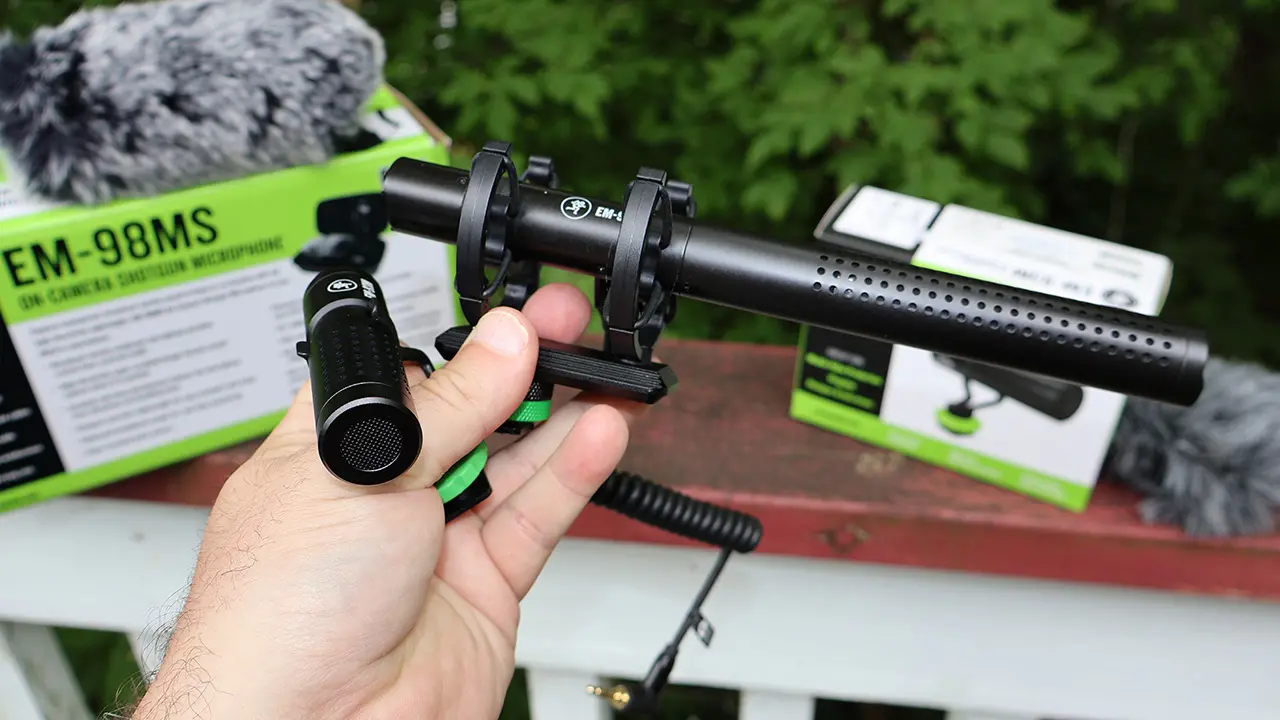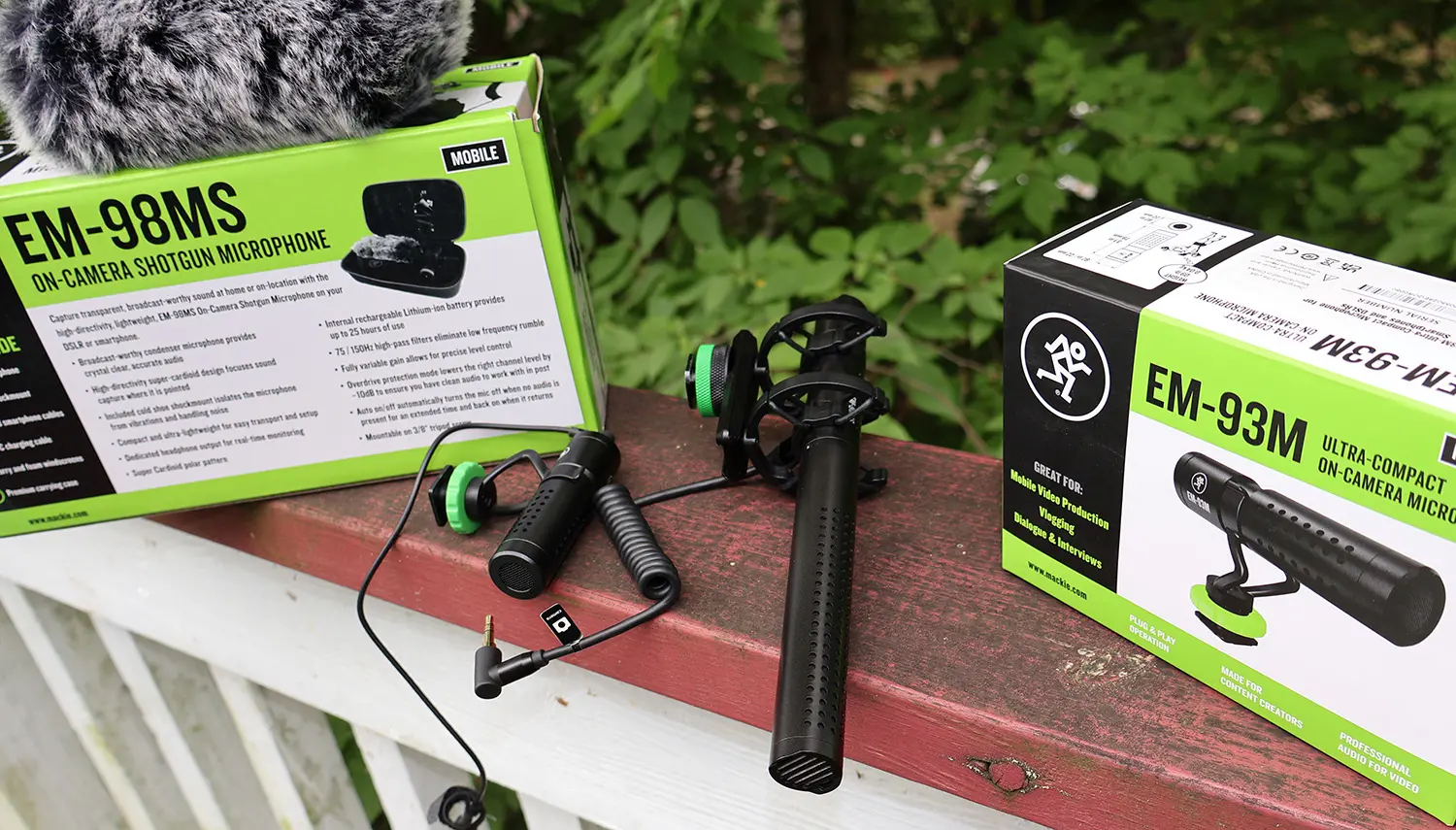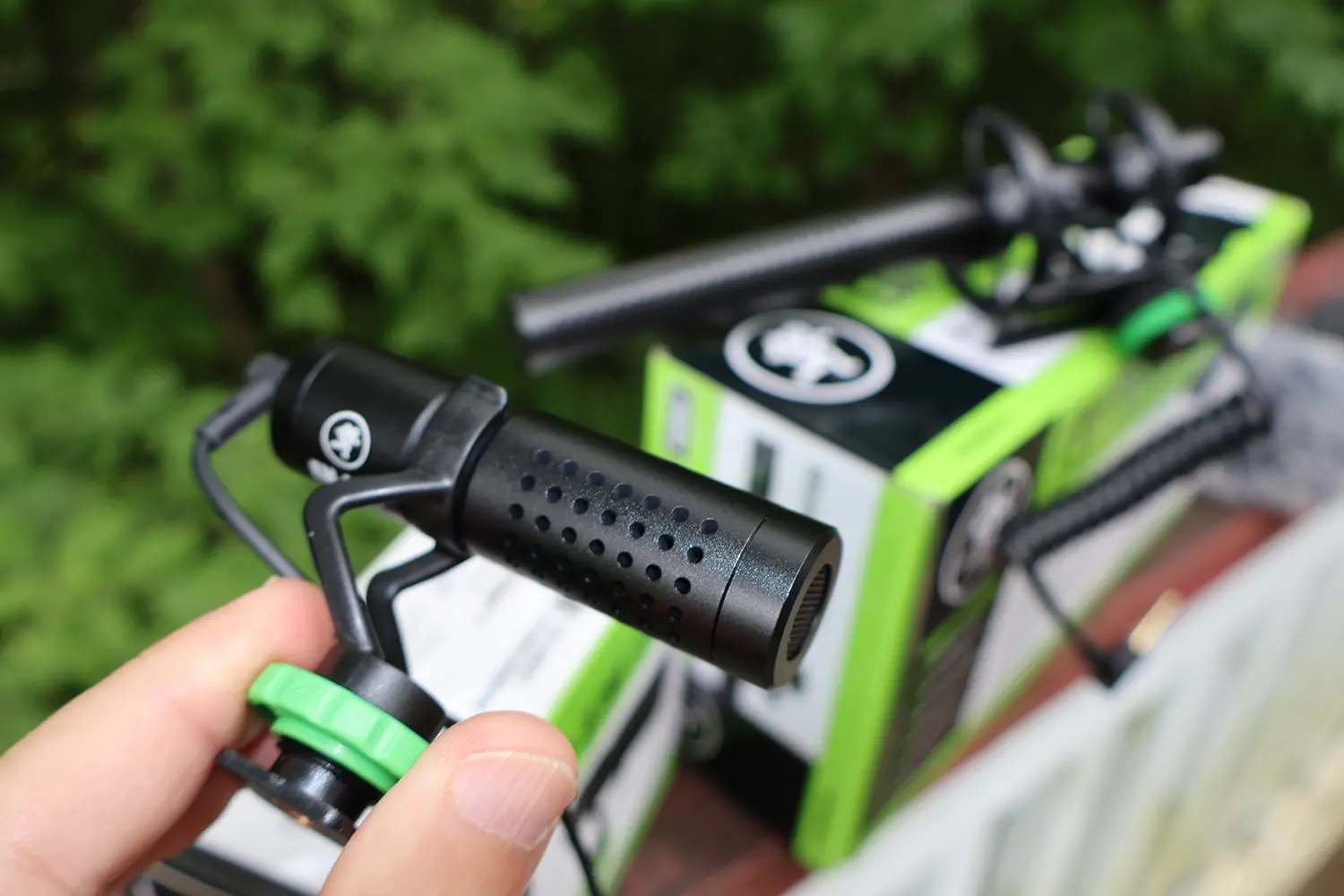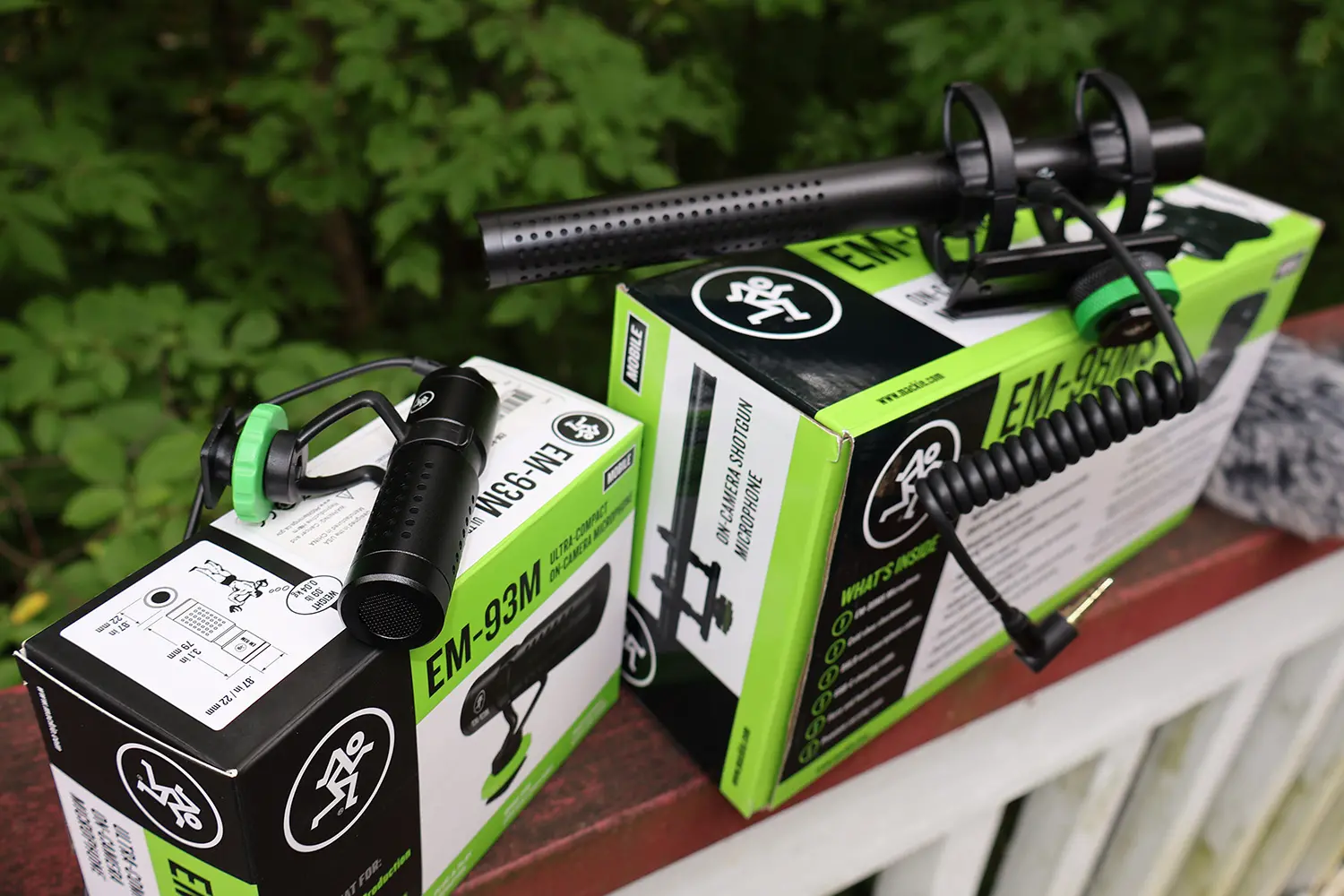
Mackie’s latest EM-93M and EM-98MS shotgun microphones, designed for personal use, look to be exemplary devices for capturing audio under a wide variety of conditions. Mackie is a brand that’s been a leader in the audio field for many years, with products designed for home use all the way up to professional installations. They make everything from mics to mixers, monitors to mighty PA systems, all with a clean design philosophy and commitment to quality products at a decent price. Do the two EM shotgun mics hit their target? Let’s see how they fared!
Mackie shotgun microphones specs
EM-93M
- Compact design for smartphones and cameras
- Weight: 40g
- Frequency response: 35Hz – 20kHz, 68dB s/n ratio
- Size: 79x23mm
- Cold shoe shockmount
- Furry/foam windscreen included
- 3.5mm cables (1xTRS to TRS, 1xTRS to TRRS)
EM-98MS
- Ideal for DSLR/mirrorless camera mounting
- Weight: 90g
- Frequency response: 30Hz – 20kHZ, 80dB s/n ratio
- Size: 216x23mm
- Cold shoe shockmount
- Dedicated 3.5 headphone jack for monitoring
- 75/150Hz high-pass filter
- Variable gain
- Built-in rechargeable batter
- Auto on/off
- Furry/foam windscreen included
- Carrying case
- USB-C to USB-A charging cable
- USB-C to TRRS cable, USB-C to TRS cable

Unboxing the EM-93M and EM-98MS shotgun mics
Unsurprisingly the unboxing experience for these two microphones differs in scope. The compact EM-93M nestles into a small cardboard box, with the furry windscreen attached and the separate foam overlay sitting beside. A small plastic bag contains the two 3.5mm cable adapters which, when used, are inserted at the end of the mic facing away from the subject.
In a larger box the EM-98MS comes already arrayed in its protective travel case. Within is the secondary windscreen and several proprietary cables. This time the hole at the rear of the mic is designed as a headphone jack, allowing you to monitor the audio coming in directly. You may twist that portion to adjust the volume level output via that fashion. Towards the front there are a series of buttons, one that powers on and off the amplification as well as selecting the recording option between dual-mono and a stereo mix that has a safety channel with a lower DB level. The second button switches between the high-pass filter curves, allowing you to remove signals below either 75Hz or 150Hz depending on what you select, ridding your recordings of unwanted rumble especially in outdoor settings.

Setting up the Mackie shotgun microphones
Both microphones are easily mounted onto the shoe slot atop your camera, although I found I had to tweak the EM-98MS’s “foot” slightly as the unscrewing mechanism can accidentally offset the inner metal portion, necessitating some fiddling to get everything behaving as it should. While the EM-93M is quite compact and essentially stays in place where it gets mounted, the EM-98MS has a bit of play on its suspension rack, meaning you can move it slightly forward or back depending on your camera’s input layout.
With both mics you can be up and running in seconds, though of course the features of the larger model do take a bit of time to set correctly. The EM-93M is the most straightforward, with standard 3.5mm jacks and conveniently labeled and colour-coded cables that easily delineate devices for your mobile device vs. your camera’s input. The EM-98MS, on the other hand, has a small USB-C port on the side that both charges the internal battery to alleviate the need for external phantom power, but also used with USB-C to 3.5mm jacks for both TRS and TRRS. This is a decent solution, given that the headphone jack occupied the 3.5 hole on the back, but I worry that these types of proprietary cables aren’t easy to replace if lost. Luckily the case is there to keep things nicely organized, and provided you aren’t quite as habitual in your habits of losing such items as I am, you should be good to go.
Sound of the Mackie shotgun microphones
I had full confidence these mics would work well under a variety of conditions, and that hope was rewarded. Shotgun mics are designed to be highly directional, capturing sound where you point and rejecting as much as possible errant sounds on the sides and behind. Both of the models do a great job at this core function.
The diminutive EM-93M performs above its weight class, providing clear, directional recordings with the least amount of fuss. Off-axis rejection was decent, and the timbre of the voice recording was certainly sufficient for most purposes. The wind rejection was adequate, especially with the fuzzy sleeve, and overall it did a perfectly fine job at capturing audio.
The jump up to the EM-98MS does add some complications, including the fumbling with the mount that I had to do, as well as threading through the audio cables. Still, once I had everything dialed in the results were definitely superior, rivalling even far more robust professional models. The longer mic tube and self-power resulted in a cleaner, clearer signal. The ability to tweak high-pass filtration on mic is a real boon, especially outdoors, and there was no sonic artifacts captured when switching between modes. The headphone output is particularly effective here for dialing in the sound, and for cameras (such as my own) where there’s a mic input but no output for monitoring this is a godsend.
The shockmounts on both mics did the trick and even when swinging the camera around there was not much in the way of transference to the mic itself. The smaller formfactor of the EM-93M would allow you to mount atop an action camera or even a phone case with a cold shoe mount, but the larger model would be ungainly in that situation. On the other hand, the larger size managed to work both on my smaller digital camera as well as a newer model I picked up, and even with its longer protrusion I didn’t find it interfering with my shot while it captured superior audio.
A lav mic still proved to provide superior audio in certain situations such as echoey rooms, but by removing the need for an additional component, and leaving the mic attached to the top of the camera, the result is something far more compact and simple to use. For everything from vlogging to shooting handheld to focusing in on wilderness sounds in a specific direction, the advantages of using shotgun mic solutions are numerous, with these Mackie models more than holding their own both out in the field and inside a room.

Final thoughts
It comes as no surprise that these mics perform as well as they do given the stellar reputation of Mackie, and for many these will up their audio game tremendously.
I particularly am fond of the larger EM-98MS, with its powerful features, but would have loved the design to have used a non-proprietary connection for audio output, perhaps putting the USB-C input for charging on the opposite side and playing a standard 3.5mm input on the left-side to route to a camera’s input.
The benefits of the EM-93M are also many, and it’s remarkable that given its light size and seemingly simple design the mic is able to capture audio as well as it does. Both models trump in-camera audio capture by a significant amount, and for situations where such shotguns really are the audio weapons of choice, you’d be in good shape with either product in your arsenal.
Shop the full range of recording equipment for content creation at Best Buy.




